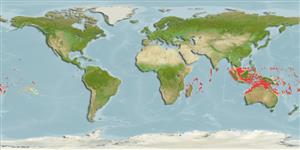Common names from other countries
Elasmobranchii (haaien en roggen) (sharks and rays) >
Myliobatiformes (Stingrays) >
Dasyatidae (Stingrays) > Urogymninae
Etymology: Pateobatis: Combination of Latin 'pateo' for 'lie open, be exposed' and 'batis' for skate, ray or flatfish; referring to the eclectic nature of members of this group..
More on authors: Jordan & Seale.
Environment: milieu / climate zone / depth range / distribution range
Ecologie
marien rifbewoner; diepte 0 - 200 m (Ref. 86942). Tropical; 9°N - 26°S
Indo-West Pacific: widespread, from South Africa to the central Pacific Islands, north to Japan (Okinawa). Frequently confused with Himantura jenkinsii (Ref. 9840).
Lengte bij maturiteit / Grootte / Gewicht / Leeftijd
Maturity: Lm 115.4, range 120 - ? cm
Max length : 183 cm TL mannelijk / geslacht onbekend; (Ref. 40637); max. gepubliceerd gewicht: 18.5 kg (Ref. 40637)
Uniformly tan to brownish pink dorsally. Inhabits lagoon and seaward sand flats from the intertidal to at least 200 m. Occurs in large aggregations (Ref. 37816).
Occurs in aggregations over soft bottoms of the inner continental shelf, often near coral reefs (Ref. 9840). Ovoviviparous (Ref. 50449). Size at birth at about 55 cm WD (Ref. 6871). Feeds on fishes, crustaceans and molluscs (Ref. 89972). Common catch of the demersal tangle net, bottom trawl and, to a lesser extend, longline fisheries. Utilized for its meat, skin (high value) and cartilage (Ref.58048). By-catch of prawn trawlers (Ref. 6871).
Levenscyclus en paargedrag
Maturiteit | Voortplanting | Paaien | Eieren | Fecunditeit | Larven
Exhibit ovoviparity (aplacental viviparity), with embryos feeding initially on yolk, then receiving additional nourishment from the mother by indirect absorption of uterine fluid enriched with mucus, fat or protein through specialised structures (Ref. 50449). Distinct pairing with embrace (Ref. 205). Size at birth ~ 55 cm WD (Ref.58048).
Mould, B., 1994. A world list of rays. The scientific nomenclature and distribution of the recent Batoidea (Batoidea, Elasmobranchii, Chondrichthyes). University of Nottingham, [UK]. 82 p. (Ref. 8630)
Status op de Rode Lijst van het IUCN (Ref. 130435)
CITES (Ref. 128078)
Not Evaluated
Gevaar voor de mens
Venomous
Gebruik door de mens
Visserij: van minder commercieel belang
Meer informatie
ReferentiesAquacultuurAquacultuurprofielKweeklijnenGeneticaElectrophoresesErfelijkheidZiektesVerwerkingMassaconversie
Tools
Speciale rapporten
Download XML
Internetbronnen
Estimates based on models
Preferred temperature (Ref.
115969): 23.7 - 28.2, mean 26.7 (based on 471 cells).
Fylogenetische diversiteitsindex (Ref.
82804): PD
50 = 0.5312 [Uniqueness, from 0.5 = low to 2.0 = high].
Bayesian length-weight: a=0.00832 (0.00366 - 0.01891), b=3.10 (2.90 - 3.30), in cm Total Length, based on LWR estimates for this (Sub)family-body shape (Ref.
93245).
Trofisch niveau (Ref.
69278): 3.7 ±0.57 se; based on food items.
Weerstandsvermogen (Ref.
120179): laag, minimale populatieverdubbelingstijd 4,5-14 jaar (Assuming fecundity<100).
Fishing Vulnerability (Ref.
59153): Very high vulnerability (90 of 100).
